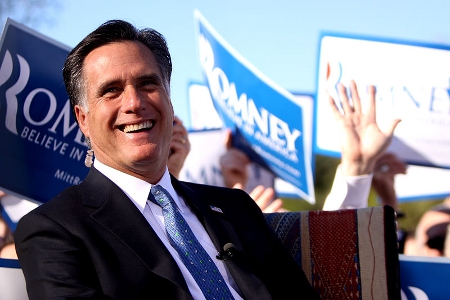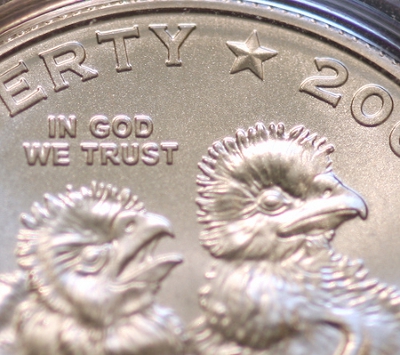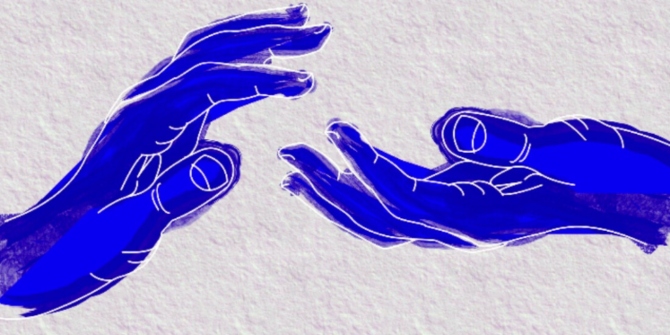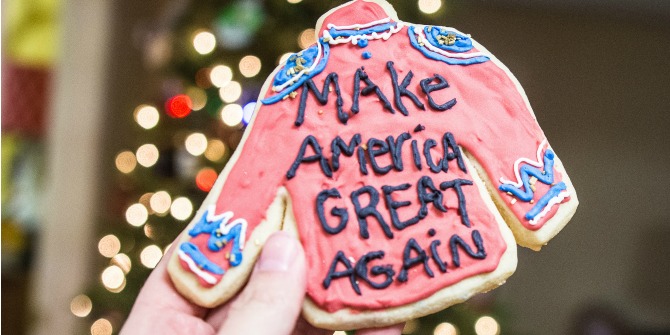 Despite the separation of church and state set out in the First Amendment of the U.S. Constitution, religion has been an important part of politics for much of the country’s history. But are the softening views towards gay marriage and the acceptance of greater religious diversity among political candidates signalling a change in American religious attitudes? USApp Editor, Chris Gilson talks to Thomas A. Tweed, the Harold and Martha Welch Endowed Chair in American Studies at the University of Notre Dame, and president-elect of the American Academy of Religion, about religion and how its role in contemporary American society may be evolving.
Despite the separation of church and state set out in the First Amendment of the U.S. Constitution, religion has been an important part of politics for much of the country’s history. But are the softening views towards gay marriage and the acceptance of greater religious diversity among political candidates signalling a change in American religious attitudes? USApp Editor, Chris Gilson talks to Thomas A. Tweed, the Harold and Martha Welch Endowed Chair in American Studies at the University of Notre Dame, and president-elect of the American Academy of Religion, about religion and how its role in contemporary American society may be evolving.
1. There is freedom of religion in the US, but is there freedom for religion?
At least as they have been enacted in legal decisions that affect U.S. religious history, the First Amendment’s two clauses have expressed two distinct but related concerns. On the one hand, since there can be no “establishment” of religion, that means there should be freedom from religion. A particular religious institution can’t be granted a privileged place in the public arena. The U.S., this clause suggests, cannot be a Baptist or a Buddhist nation. On the other hand, the other clause protects citizens’ right to the “free exercise” of religion, or freedom for religion. It’s only a slight exaggeration to say that many of the public squabbles about contemporary moral and political issues—from prayer at school graduation ceremonies to access to abortions at government-funded clinics—can be understood in terms of which clause the participants value most highly.
Over the years different courts and legislatures have worried more about one clause than the other, but, yes, it is safe to say that there has been protection for most forms of religious practice in most social spaces. Some Jews will tell you that the U.S. very much seems like a Christian nation from where they stand. Some Catholics will complain that the Affordable Health Care Act’s rules about contraceptives restrict their ability to practice their faith as they want. Some Muslims will say that praying at work is more challenging than it should be. But to a remarkable degree there has been freedom for religion.
2. How do you explain Americans’ recent move towards acceptance for less traditional religions such as Mormonism in their politicians? Do you think that national politicians and political figures will ever have the freedom to not have religion?
You raise two very interesting questions here. On the first question, about Mormonism, I was surprised that there was not more controversy about the Republican candidate’s affiliation with the Latter Day Saints in the last presidential election. I had predicted—I was wrong—that Governor Mitt Romney would have to give a major speech, much like John F. Kennedy’s famous 1960 Houston speech, defending himself and declaring his unconditional allegiance to the U.S. tradition of church-state separation. Governor Romney said the right things—though apparently not enough right things to get elected—but there was less expressed hostility and media scrutiny than many of us expected. I am not sure why, but three reasons come to mind.

First, in President Obama the Democrats had a candidate who had endured his own controversy about religion during his first campaign, and for varied reasons they decided it was not an appropriate—and/or strategically sound—issue to foreground in public debate. Second, many of those who might have been expected to worry most about the particulars of the Mormon faith, for example some evangelical Protestants, were also President Obama’s most impassioned opponents. Perhaps the sense that they shared a common enemy led many to suppress public expression of private anxieties. Finally, what counts as “less traditional” changes over time, and the pattern in the U.S. has been for marginalized groups to eventually gain some minimal acceptance, sometimes even political power. In the colonial period, some Protestant churches that would go on to have national prominence and regional clout, like Baptists and Methodists, were originally seen as “dissenting” groups. Jewish and Catholic immigrants weren’t warmly embraced as they stepped off ships during the nineteenth century. Anti-Semitism and Anti-Catholicism continue, of course, but followers of both faiths are hardly outsiders in politics. Just look at their representation on the U.S. Supreme Court: there are six Catholics, three Jews, and no Protestants. Any observers, who saw that coming, deserve warm congratulations. I certainly did not.
On the second question, whether national politicians will ever be able to declare themselves religiously unaffiliated or non-religious, I might end up being surprised again, but my sense is that we might see a Muslim, Hindu, Jewish, or Buddhist U.S. president before we see an avowed atheist. Some survey data supports that hunch. Of course, the uncertain factor in all this is the younger generation. Do they continue to be less inclined to join religious organizations than their parents and grandparents? How about their children? If so, perhaps a robust secularist, or a candidate who is “spiritual but not religious,” might get to the White House first.
3. Are debates about abortion and gay rights simply religious debates in disguise?
Yes, for the most part, but in public protests in front of abortion clinics or state capital buildings there is usually not much question about which constitutional clause the sign-carrying protestors cherish and there’s not much “disguising” of the their stand on religious affiliation—or unaffiliation. There are surprising counterexamples, as with the evangelical with a lesbian daughter who softens or challenges his congregation’s official stand on the issue, and, more generally, U.S. attitudes toward homosexuality seem to be changing, the quantitative evidence from surveys tells us. The shrillest voices do not represent the more nuanced opinions of the majority.
But in the U.S. the public divides about gender and sexuality usually seem to reflect deeper conflicts about moral values that, in turn, are grounded in terms that might be framed as religious. That’s one reason that the positions seem so intransient and the debates have been so nasty. Many of us have called for civil discourse that politely recognizes differences while striving for pragmatic solutions rooted in shared goals, but, as you might have noticed from the news, those efforts have not been greeted with widespread enthusiasm. Ungenerous discourse and shrill debates continue.
4. Despite their being a separation of church and state, artifacts of religion are common in public life, e.g. on money, within the pledge of allegiance. Do you think that this is appropriate?
Sometimes religious symbols have appeared in civic spaces and political ceremonies in ways that seem to approach, even cross, the boundaries mapped by the First Amendment’s “establishment” clause, and this long-standing practice might befuddle some observers around the world. But since the late-eighteenth century U.S. political life has held in tension twin impulses: a concern to steer clear of any privileging of a particular religious tradition and a (grudging or enthusiastic) acceptance of what scholars have called “civil religion” in some governmental spaces, like capitals and courthouses, and in some solemn ceremonies, like Memorial Day parades and presidential inaugurations.

Since the 1970s, scholars have pointed out that the claim, or presumption, that all Americans affirm this civic piety overstates agreement and ignores dissent. Not all Americans—including some African Americans, American Indians, non-Christians, and atheists—have been as eager to sacralize government spaces and civic rites. American Buddhists, for example, don’t accept the theism—the belief in a personal creator of the universe—implied in most civil religious expressions, so that while many of them have been happy, even eager, to express their patriotism, some have been unsure what to make of U.S. coins that urge they trust in God or school rituals that demand they proclaim their nation is “under God.” And there have been public expressions of that dissent, even legal challenges. I once signed a friend of the court brief, for example, in a U.S. Supreme Court case about the pledge of allegiance, as I joined my scholarly colleagues in confirming that in the 1950s members of religious groups, mostly Catholics and Protestants, advocated for the addition of the phrase “under God” to that civic rite. That 2004 legal challenge was unsuccessful, as I suspected it would be. The contested but familiar mix of legally sanctioned religious disestablishment and religiously inflected political symbolization is still with us.
5. How do you think religiosity in the US will change as the demographics of the country change as this century unfolds?
You’ve probably already noticed my caution—and mixed record—at predicting religious trends. But since I show no signs that I’m able to learn from past mistakes, I’ll offer a few thoughts about how the changing demographics might affect U.S. religious life. But I’m not the only one who can’t predict things. As he signed the 1965 immigration Act that led to accelerated transnational flows, President Lyndon Johnson wrongly suggested that it “would not affect the lives of millions.” Unforeseeable factors also can open and close the gates, just as counter-immigration campaigns and U.S. economic recession slowed the migration from Latin America by 2010.
However, if the current immigration trends hold, with the majority of new Americans hailing from Latin America and Asia, the ethnic and religious diversity of the population will at least be maintained. Some faiths, including Roman Catholicism, will have more Latino members, since most Latin American migrants claim Catholic heritage. About 80 percent of the newcomers from the largest sending nation, Mexico, are Catholics, even if a small but significant proportion of transhemispheric migrants claim Protestant affiliation. And, the surveys suggest, those Latin American migrants are even more religious than the U.S. adult population, just as other migrants, for example the Chinese, report that they have reaffirmed their heritage faith, for example Buddhism, or turned to a new faith, for example Christianity, in their adopted land. It’s unclear whether all this will counter the secularizing patterns we see among some native-born citizens. It might. In any case continued immigration might lead observers in another decade or two to suggest that, for good or ill, religion continues to play an important role in American life.
Please read our comments policy before commenting.
Note: This article gives the views of the authors, and not the position of USApp– American Politics and Policy, nor of the London School of Economics.
Shortened URL for this post: http://bit.ly/1evKDTz
_________________________________
 Thomas A. Tweed – University of Notre Dame
Thomas A. Tweed – University of Notre Dame
Thomas A. Tweed holds the Harold and Martha Welch Endowed Chair in American Studies and has a concurrent appointment in History, at the University of Notre Dame. He is also Faculty Fellow in the Institute of Latino Studies and the Kroc Institute for International Peace Studies. He edited Retelling U.S. Religious History and co-edited Asian Religions in America: A Documentary History, which Choice named an “outstanding academic book.” He also wrote The American Encounter with Buddhism, 1844-1912: Victorian Culture and the Limits of Dissent and Our Lady of the Exile: Diasporic Religion at a Cuban Catholic Shrine in Miami, which won the American Academy of Religion’s book award. His most recent book is an historical study of the Basilica of the National Shrine of the Immaculate Conception in Washington, which appeared in 2011 as “America’s Church”: The National Shrine and Catholic Presence in the Nation’s Capital, 1917-1997. He has served as the president of the American Society for the Study of Religion, and in 2014 he is president-elect, and future president, of the American Academy of Religion.






